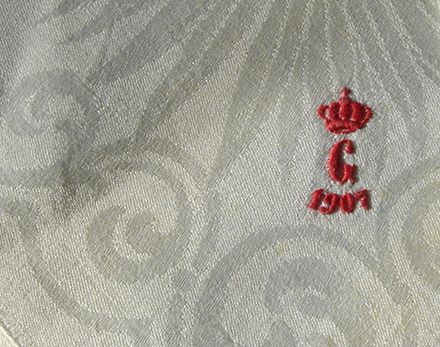Let them embroider monograms...
Marie Antoinette is known for many things by many people, but thanks to a new exhibit at the Victoria and Albert Museum, her role in making monogramming a key fashion and interiors feature of 18th century Europe is revealed. The exhibit overall celebrates the lasting legacy of Marie Antoinette in the decorative arts, fashion and film over the 232 years since her death. And it is dazzling... a feast of huge skirts and tiny corsets, embroidery and satin bows, gold and silver and diamonds... and lots of monogramming.
Of course there was monogramming for centuries before Marie Antoinette’s time in the 18th century. The use of monogramming domestic goods began in the Middle Ages, are usually took the form of a combination of initials and an aristocratic coat of arms or family crest. Monograms were applied to personal property to indicate ownership rather than for ornamentation, and were not always embroidered. In 14th-century France, for example, standard household linens would be marked with an ink monogram. French kings, on the other hand, had the distinction of having the only linens with embroidered markings which typically included a fleur-de-lis, the traditional symbol of French royalty.
The practice of monogramming bed, bath and table linens continued through to the 18th century largely as a means of identifying them, as laundering was a communal task. Often whole villages would participate in the weekly laundry duty. Monograms on laundry were embroidered primarily in red as madder was the most common, most durable and the least expensive dye available for thread. Red thread for monogrammed bed and bath linens remained popular in France through the end of the 20th century, despite the wide range of thread colours that were then available.

Lettering for early monogramming was either Gothic style, a handwriting font used since the Middle Ages, or Roman style used in printing presses. However, new and more sophisticated font styles developed which added ornaments and flourishes such as leaflets, flowers, raised dots, shaded lines and scrolls to lettering. Books of embroidery designs began to be published throughout Europe and were used for design inspiration by embroiderers, woodworkers, stone cutters, silver engravers and anyone else who monogrammed their work. A page from one such book is on display at the V&A:

Monograms in the time of Marie Antoinette
Marie Antoinette was a prolific user of monogramming, although interestingly she didn’t often use a crown in her monogram. She mostly used a simple combination of her first two names, overlaying one initial with the other.

There are examples of other more elaborate monograms, however, including this ornate version of the two initial monogram marking an entrance:

Very little of Marie Antoinette’s possessions survived the French Revolution. There are some beautiful artefacts in the V&A exhibit, although most are recreated. The Metropolitan Museum of New York owns a collection of pieces of furniture from her dressing room, including this chair which was loaned to the V&A for the current exhibit and is in extraordinary condition, including a carved and gilded monogram at the top of the chair. Its matching settee features a monogrammed pillow.

Marie Antoinette was herself a talented embroiderer and a gorgeous example of her work, which is also owned by the Metropolitan Museum but too fragile to exhibit at the V&A, is a cotton covering from a fire screen. Although the cotton is now quite discoloured, Marie Antoinette's interlaced initials, composed of blossoms embroidered in satin stitch, are in remarkably good condition and demonstrate her hand embroidery skill.

Monogrammed silver pots and a basin from her dressing table are also on display. We found it interesting that she used a simple MA monogram without a crown, the standard practice for royal monograms. The font style on these items is very similar to one we use today called Monogram Couture.

Some very pretty brooches also survived, one elaborately monogrammed with the regal flourishes:

Two replicas of a diamond necklace once said to have passed through Marie Antoinette’s hands, with a bit of controversy along with it, is also on display. This one, made from faux gemstones, looks almost identical to the original which was said to be the most expensive necklace ever made at the time:

This one, made by Chanel, demonstrates even more clearly how the design of the necklace, even when pinned to the bodice of the dress, makes the shape of a monogram… M.

The V&A’s curator affirms, “The queen applied her monogram everywhere… This highly successful form of early modern branding has ensured the monogram’s continued association with luxury and refinement today.”
The exhibit is decadent and yet melancholy, for she was a very young girl when she was married to a very young boy and sent away from her large family in a much different country to learn how to be a French queen. And at time when very few people in France thought a French queen was necessary. History has cast her as a villain but she did quite a lot for the fashion and decorative arts economy in France, throughout Europe and beyond. If a man created that much value, without destroying much in the process, he’d be viewed as a hero. It’s worth visiting the exhibit to form your own opinion.
